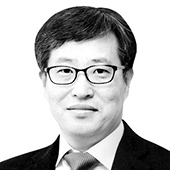Everything has its own time
Published: 09 May. 2021, 19:36

The author is a columnist of the JoongAng Ilbo.
Some 30 years back, a joint research room in my college had only two desktop computers. Every time we used them, we had to insert a floppy disk into the PCs with no embedded hard disk drivers. Yet the price of the computers was nearly two times the starting salary of large company employees at the time. The speed of technological development is dazzling. When I searched prices of 16-gigabyte USBs last week, most of them cost less than 10,000 won ($9) each. Given their fancy price in the early 2000s — as high as 1 million won per USB — that’s an incredible decline.
The dramatic fall in digital product prices was primarily driven by semiconductors. A1-megabyte DRAM cost $6,480 in 1980, but the price went down to as low as $0.0037 last month. That’s nearly a one-2,000,000th contraction over the past 41 years. The revolutionary shift is impossible without a technology advancement at the speed of light.
Korea’s semiconductor industry worked a miracle after overcoming tremendous competition for technology. For chipmakers, maintaining a tech edge is a matter of life and death, as their “fixed costs” are overwhelmingly higher than “variable costs” — such as personnel and materials costs — than any other industry. Therefore, if a company secures strength in fine processing through design improvement or new equipment, it can produce more chips out of a same-sized wafer than competitors. That assures the company of excess earnings while the laggards are being forced into a long tunnel.
If the company were a bakery shop, it could find ways to survive, for instance, by changing recipes or moving to other neighborhoods. But chipmakers cannot do that. They can’t stop production after investing heavily just because chip prices plunged. They cannot but wait for a better time to come. In that hostile cycle, chipmakers often lose their ability to refine technology and see their competitiveness fall. That’s a path Japan and Germany’s memory chipmakers took before their demise starting the 1980s.
![Flanked by Samsung Electronics’ Vice Chairman Lee Jae-yong, left, in its Hwaseong plant on April 2019, President Moon Jae-in signs on the world’s first 7-nanometer circuit wafer the company developed using extreme ultraviolet (EUV) lithography equipment on the sidelines of the government declaration of the “System Semiconductor Vision.” [YONHAP]](https://koreajoongangdaily.joins.com/data/photo/2021/05/09/d20b7531-1829-423a-ab92-4178e7cb90a3.jpg)
Flanked by Samsung Electronics’ Vice Chairman Lee Jae-yong, left, in its Hwaseong plant on April 2019, President Moon Jae-in signs on the world’s first 7-nanometer circuit wafer the company developed using extreme ultraviolet (EUV) lithography equipment on the sidelines of the government declaration of the “System Semiconductor Vision.” [YONHAP]
Despite U.S. President Joe Biden’s demand for Samsung’s semiconductor investment in the United States, the company is still deliberating before making a decision — even four months after it came forward with a bold proposal to build a new foundry manufacturing line in Austin, Texas. Given such structural risks and challenges involved in chipmaking investments particularly when Vice Chairman Lee Jae-yong is put behind bars for bribery, Samsung’s dilly-dallying can be understood.
But in the meantime, Taiwan Semiconductor Manufacturing Company (TSMC) has swiftly jumped on the U.S.-led bandwagon by announcing an ambitious plan to build five additional factories in Arizona within three years. Intel also moved fast after declaring to reinforce its foundry production. Such sensitive moves contrast with Samsung which could seize an opportunity to keep abreast of the pack through drastic decisions. The foreign media predict that Samsung will have trouble catching up with TSMC in foundry.
The Korean economy is about 10 times bigger than in 1987, when Chairman Lee passed away. During the period, Samsung Electronics’ market cap grew 1,200 times larger. As a result, the Moon Jae-in administration could get 12 trillion won in inheritance tax from the bereaved family of Samsung Group whose Chairman Lee Kun-hee died last October. That’s just like an unexpected gift from Samsung. The United States chose Korea as a strategic ally on the semiconductor front four decades ago and the end of the Cold War opened the vast Chinese market. The wave of a fourth industrial revolution triggered an explosive demand for chips. But concerns are growing fast that the market may close down sooner or later if Samsung and the government are taken hostage to the past and continue dragging their feet.










with the Korea JoongAng Daily
To write comments, please log in to one of the accounts.
Standards Board Policy (0/250자)